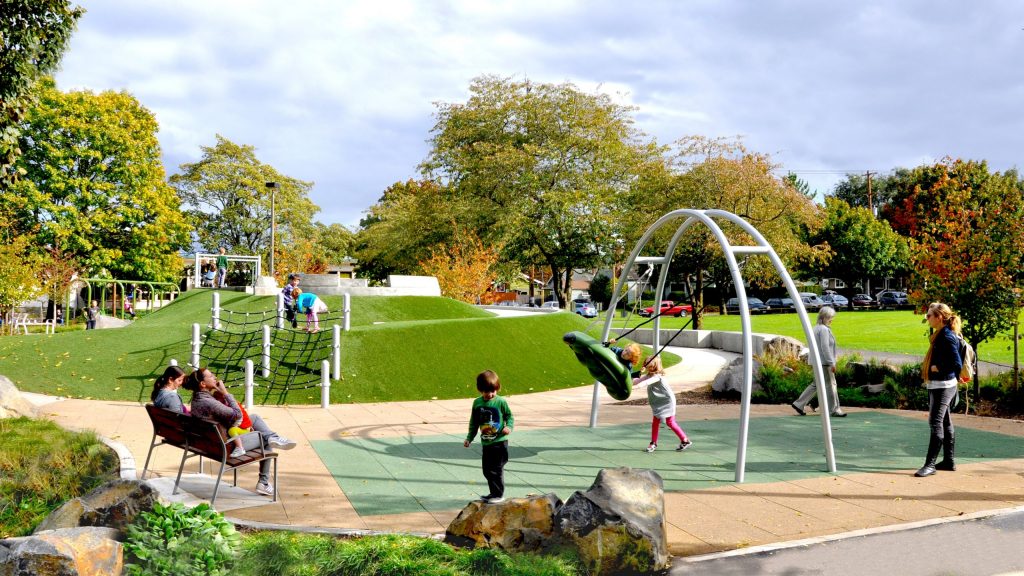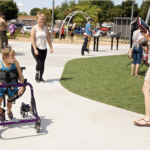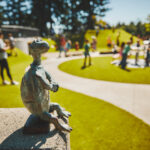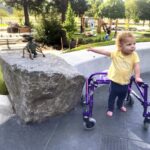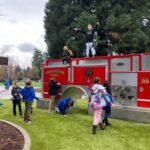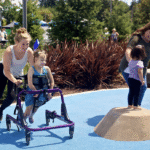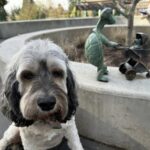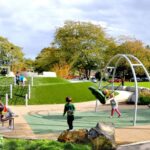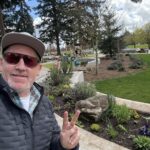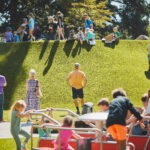
By: Janet Roche & Carolyn Robbins
- Hosted By: Janet Roche
- Edited By: Cedric Wilson
- Guest: G Cody QJ Goldberg- Chief Play Officer, Harper’s Playground
- Photo Credits: Harper’s Playground
Designing for: Inclusive Playgrounds… Keeping the Fun in Function
(Season 6, Episode 3)
How do you create playgrounds that are both fun and functional? Join Inclusive Designers Podcast as G Cody QJ Goldberg- Chief Play Officer of Harper’s Playground- spills the dirt on how to design spaces where every body can play.
Guest: G Cody QJ Goldberg- is the Chief Play Officer of Harper’s Playground, a non-profit committed to creating opportunities that allow both disabled and able kids to play together. Their vision is to create a more inclusive world, one playground at a time.
– References:
Designing for: Inclusive Playgrounds (Season 6, Episode 3)
(Music / Open)
Janet: In this series we will be discussing specific examples of design techniques that make a positive difference for people living with certain human conditions.
Carolyn: The more a designer understands the client and or the community the more effective and respectful the design will be.
(Music / Intro)
Janet: Welcome to Inclusive Designers Podcast, I am your host, Janet Roche…
Carolyn: And I am your moderator, Carolyn Robbins… And we have a very fun episode for you today! Because what is more fun than talking about playgrounds?
Janet: … talking about inclusive playgrounds, of course! But most play spaces are not designed for every body, especially for kids and families with disabilities. It’s so important for everyone to have the chance to play… and to play together.
Carolyn: You might say it’s a very ‘moving’ topic…
Janet: (chuckles) That’s funny, but it’s also true! And we’re happy that Cody Goldberg, ‘Chief Play Officer’ of Harper’s Playground, is joining us. Carolyn, can you tell us a little bit more?
Carolyn: Yes I can… Cody will share with us how his career focus changed from brand marketing for companies like Adidas and Red Bull to creating accessible playgrounds… all after he took his daughter to a playground that was not wheelchair friendly.
Cody co-founded the organization, Harpers Playground, in 2010 along with his wife April. Together they spearheaded the design, funding and construction of the first Harper’s Playground in Portland, Oregon. And it’s been followed by many more since then.
A big fan of inclusion of all kinds, they are committed to creating opportunities that allow both disabled and abled kids to build friendships and community.
Janet: And they believe that a well-designed, and realized, inclusive play space can truly transform a community… for the better.
Carolyn: According to the Harpers Playground website, their vision is to create a more inclusive world, one playground at a time.
Janet: I think it’s time to hear directly from Cody on how he got into this field, or in this case, playground… (chuckles)…
Carolyn: Of course! It’s his turn to play. So here is our interview with Cody Goldberg…
(Music 2 – Interview)
Janet: Hi, and welcome to Inclusive Designers Podcast. Today we’ve got a fabulous show for you. We’re going to be talking to Cody Goldberg, who is a wonderful inclusive playground designer. And so welcome Cody. Thank you for joining us today.
Cody: Janet, it is really nice to be here. Thanks for having me.
Janet: Yes. We’re so happy to have you. It’s one of those things where Carolyn and I have been looking forward to doing this episode on inclusive playgrounds because it’s really so important and it is really fascinating. And I’m sure like you, you see a lot of images as a designer that come up and say that they’re inclusive designed playgrounds, and yet they are not.
And I get a lot of that with students from my classes, they’re like: “look, here’s this little outdoor play area and it’s inclusive.” And I would always say: “does that rope ladder look like it’s inclusive? Getting up to the second floor, you know, the second level or, or what have you?” And I would argue probably not. They are like: “well, but it was labeled as inclusive.” I’m like: “I’m not quite sure who thinks that was inclusive, but clearly, it’s not. Once you take a look, it’s really just not.”
And the other egregious piece I always tend to kind of see is when people have the mulch on the ground. You know, that was a big fan favorite in the 90’s. And that is also, now not considered inclusive. And we could talk about that at some point, because it’s a little pet peeve of mine, besides the little playground sets that say they’re inclusive.
But I want to start off and talk to you and get your thoughts and ideas of what an inclusive playground is in your terms and in your philosophy and under your discussion.
Cody: Yeah. Really great tee up for probably one of my most passionate pieces of this work, which is the term ‘inclusive’ and how it does not have a definition, at least when it comes to playgrounds. Well, it does on our hand.
Harper’s Playground has a definition, so I’m very excited to share with you what that is. But there is no official one, right? There’s no governmental regulation that says what someone can call inclusive or not. So it’s the Wild West right now (Janet: chuckles), in inclusive playgrounds. But at least, it’s a big conversation topic and it didn’t used to be at all. (Janet: right). But I’ll share with you our definition because it’s pretty sweet and simple and that might be a good way to start here.
Janet: That’d be great.
Cody: We start with what we call ‘physically inviting’ as the base layer, yet most important component. So that’s where accessibility, if you use wheels, you can get everywhere. (Janet: right). And we all know that those wood chips, they’re not accessible actually (Janet: for anybody), and then adaptive.
And we’ve arrived at that through the two key questions: Can someone get to the thing; and then when they get there, can they use it? So accessible and adaptive, that’s physically inviting. That’s the first of three layers, that all piled together can become inclusive playgrounds if they’re all done right.
The second layer we call ‘socially inviting’. So again, to remind you, it’s physically inviting, (Janet: right), and then it’s socially inviting. And the way we achieve socially inviting spaces is first through thoughtfully laying out community gathering spaces and choosing equipment that encourages social connection.
The equipment that we put in, or the features that we put into a playground, not only are they adaptive, but they primarily are only selected if they’re going to encourage teamwork. A spinner that requires a group of people, a group of children to spin it together. Well people, because we designed for all ages and abilities too (Janet: laughs). It’s not just kids. (Janet: right). Everybody needs play.
Janet: Well, that’s just it. You know, I’m very mindful when I’m designing. I’m looking for places to play and have movement. (Cody: mm-hmm). I mean, it’s such an important piece to humans’ health and wellness, (Cody: yeah, absolutely). So…
Cody: So there’s two pieces to each layer. So again, physically inviting is accessible and adaptive, socially inviting is community gathering spaces and nature. So the inclusion of nature— inclusion being a pun here for sure (Janet: chuckles)— but nature puts us in a more social mindset, right? And more willing to connect with friends and neighbors when we’re in a natural setting. So we definitely put as much nature into our play spaces as possible or natural features.
A really central feature for Harper’s playground is what we call Harper’s Hill, because it’s not only beautiful and elegant, but it’s very usable in many ways, has many play affordances.
And then finally, the least easy to define, but the real, the cherry on the top is, ‘emotionally inviting’ the third layer. And that’s where artwork, musical instruments, and thoughtful details. I think it is in the specific small details, the choices that you make about placement, that makes somebody feel emotionally welcomed in the space.
So physically, socially, and emotionally inviting spaces. Those done right, become a ‘Harper’s Playground certified naturally inclusive playground’. (Janet: laughs). So there’s a definition.
Janet: Right! And I love it. And, and those three aspects are very important because I think what you’re getting at is that the physical part, even though a lot of times this fails miserably anyways, that’s the one that people tend to focus on as opposed to the social and emotional, right? (Cody: hmm). So, I think that that’s something that’s, you know, really key for a good inclusive playground. (Cody: yeah).
Yeah, so, I think we want to talk about the aspects of nature at some point. We’ll get into that in a little bit because it’s an important piece in talking about the ideas of open and free play, the benefits of even just playing with the stick. (mm-hmm). And in the dirt, you know, is something that I think that all kids can kind of agree or older kids, grown up kids can remember doing at some point and the benefits of that. So we’ll get into that to in a minute.
But why don’t we go just take a step back a little bit and talk about, you know, how you got into this and maybe you can share with our listeners a little bit about your story and how you’ve gotten to this point.
Cody: Yeah. Thank you. I think, it goes all the way back to my own childhood in that I always dreamed of having a career that was not a career. (Janet: laughs), I didn’t want a career actually at all. (Janet: we all want that). I always wanted to find my passion, (Janet: yeah, yeah), to pursue my passion and that, I luckily had parents who both said, ‘we don’t care what you do, we just care that you find something that you love to do.’
So I start there as a baseline because fast forward to my opportunity to become a father myself. And it’s the birth of my first daughter, Harper, the namesake of our organization that led me to figuring out what my passion in life is. (Janet: yeah). She was born with a very rare genetic difference. We were told she would never walk or talk in her lifetime, shortly after her birth. And yet 4-years later, she learned to walk with a little walker, a little wheeled walker, and we took a walk in our neighborhood park, literally the first day she learned how to use it. (Janet: yeah).
And we ended up at the playground at the far end of the park, and she immediately got stuck in those wood chips. (Janet: aww). Those wood chips that you mentioned earlier.
Janet: Oh, yeah. Yeah. Rotten wood chips, right?
Cody: Yeah. And she was darting towards that structure. (Janet: right). She was excited to get there, (Janet: right). And then, she got stuck. And so, I don’t think we had any choice but to launch Harper’s playground to fix that problem. So it was really my wife’s idea that we do something about it. And our first effort was to tell the Parks Bureau that they should do something about it. That’s what we were going to do.
And they said they had no budget— budget is often the excuse for not doing the right thing. (Janet: right). So we said, ‘okay, well if budget’s the problem, we’ll, we’ll do it.’ And so we had a bake sale in front of our house and 3-years later we had raised $1.2-million dollars, and we had designed something really special with a group of excellent designers. And I think most impressive, we got it built. (chuckles). That’s definitely the hardest part. (laughs).
Janet: Right, although I’m impressed with, you know, started off as a bake sale, ended up with $1.2-million dollars. I’ll have to talk to you offline about how that works and I’m going to have to learn how to bake I think, so. (Cody: yeah. yeah). But, right, (laughs), but you know, we muddle on.
So that’s a, you know, it’s a really like sweet story, but how long did it take you from raising those funds? Because I want to talk a little bit about the economics of all of this, because I think it’s, it’s actually a really important part. But how did that, you know, going from the bake sale to actually the completion of the project?
Cody: Yeah, well, I think probably the most important part of the, you know, the bridge here is that I was not a playground designer when I started this work. I was really wonderfully overwhelmed and even nervous about sitting down at the table with designers. I didn’t know what I might have to offer. (Janet: interesting).
But I had two questions in mind that I started with: one— could Harper get there? And two— could Harper do something when she got there? And then I think eventually the third question I started thinking was: is the space worthy of her? She is this beautiful being, deserving of being in a beautiful space. (Janet: beautiful place, right).
And as part of that too, what is the ultimate goal? Is it so that she can play? No, it’s actually so that she can connect and be part of community. (Janet: right). So those questions still guide our design theory today. Like, I don’t mind telling people, if you design a playground for Harper, it will be good for everyone, (Janet: right).
If you understand the right questions to ask, because when we design for the most vulnerable, which Harper really does represent (Janet: yeah), that she really is a beautiful and strong and wonderfully vulnerable human being in the way that she doesn’t even have defense reflexes. If she falls, she’ll, you know, hit her head.
So, when we design for people like Harper, we design for everybody. (Janet: right). And when we put the North Star as social connection, human contact, (Janet: right), we can recall that we don’t have to try to put every single thing into the playground.
One of the big issues with those structures is not only are they not actually in line with how human beings want to engage environments— the structure is not the ideal thing, a landscape is— but interaction with inanimate objects is not the goal. Interaction with other human beings is. (Janet: right). And a very simple and elegant space will do that.
So it started with those questions. And now I am almost willing to call myself a decent designer. (Janet: laughs). Because that’s a big word, design. Like there’s a big thing, but I love to instruct other parents, like myself: ‘you’ve got it, you’ve got it in your heart to become a good designer if you keep it simple and ask the right questions.’
Janet: … and ask the right questions. Yeah, it’s so important. And if you’re a listener to the podcast, you know that that is sort of like the backbone of all the designers, is asking the right questions. And it’s thoughtful, empathetic, and just ‘thinking it all through’ kind of questions. And to your point, it can just be something very simple too, right? Like, how do we get from point A to point B? Like, how is that working? Right? (Cody: hmm).
So it’s a really important component in terms of the work that you’re doing. And especially considering, there are more and more inclusive playgrounds being put into urban areas and suburban areas and so on and so forth. But again, I still feel that a lot of people are throwing out their shingle out there and not really thinking through what they kind of need to do.
And one of the playgrounds that I was told was an inclusive playground, and when I got to it— it’s in Boston. I probably shouldn’t give away too many secrets. (Cody: laughs). I don’t want to get into too much trouble— but it wasn’t, I wouldn’t say it was all awful, right? (Cody: laughs). But there were so many gaps that I just thought to myself, I’m like ‘oh no.’ (laughs). And so for you listeners, we make sure that we’re also asking the right questions. (Cody: hmm).
So speaking of which, why don’t we start with that? I mean, is it those simple questions, can somebody like Harper get from point A to point B? Is that your go-to at this point? Is that your kind of like gold standards of questions that you start with? You know, I’m assuming we kind of look at the space, right? And we start with some of the essentials, right? (Cody: mm-hmm). But are there definitely other questions that like always kind of pop into your mind when looking at different areas for different spaces?
Cody: Well, I mean, absolutely. There are so many questions to begin with. For us, it’s often, is the team that is interested in engaging with us, are they on the same page? (Janet: bingo. right. yeah). Are the stakeholders truly committed to doing it right? So there’s a dance that goes into a courtship period that goes into when people think about doing something. We are looking for people with similar passion as us, and not everyone has that. (Janet: no). That’s for sure now. (Janet: yeah).
Or they don’t necessarily have the same vision of what it is. So we look to have a lot of community engagement before committing to a project, making sure that who we’re going to work with really wants what we do. And we have definitely a very strict definition of inclusive design, which means people have to be in line with it and excited about it. (Janet: right, right.)
And the least negotiable is that first layer, right? I mean, we need people to understand that’s not negotiable at all. The other parts are negotiable in that they’re a little more fluid, you know, the artwork choices, those are community choices, for instance. Right? (Janet: right).
We’re not going to dictate what art is, but you know, we’ll make sure that the art is accessible still. Like, we won’t allow art to be so far away, like so high, that somebody couldn’t access it. But we wouldn’t tell a community that’s art or that’s not art. (Janet: yeah). But we would tell them, and we want them to be signed on to what accessible really means and what adaptive really means. (Janet: right).
Site selection is the next piece, right? I think making sure you design to a site. We’re very passionate about making sure our playgrounds fit the environment, not imposed on the environment. (Janet: right). They have to integrate with the environment. It’s just, it’s critical. (Janet: mm-hmm). That is part of the entire experience. (Janet: mm-hmm). If the playground feels like it’s part of the landscape, then that’s a different emotional feeling than if it’s like a rectangular fence, just plopped into a space. No, that’s not good. (Janet: no).
So the right team and the right location, making sure those are in place. And location is not just the environment, but is it the right space, is it a good accessible space within the landscape of the city, let’s say? (Janet: right). Right, so you’re looking at mass transportation, existing trees, existing amenities within rolling distance, all those key questions. So, so many questions to be asked. (Janet: chuckles). I think that’s a lot of them right there (chuckles).
Janet: Right. I think so too. Well, I mean, we’re not going to probably hit on everything that we are going to want to, you know, be like masterclass with Cody, (Cody: hmm). but we can always have you come back to Inclusive Designers podcast.
Cody: My favorite subject. I’m happy to talk about this all day, every day.
Janet: All day, every day. Like I said, I feel like we’re really… I feel like its time has started to come. Plus we were also so familiar now with how important movement and play is. I mean, it’s something that you always kind of know, but sometimes it gets, you know what I mean? It just falls off the radar at some point.
So with your lessons, and now you are an inclusive designer playground expert. So, what are the essentials? Is there a checklist or, we always talk about it in trauma-informed design, that there’s no real checklist, (Cody: hmm). Because we’re always trying to make spaces for the people that are there, right? So, that includes the community, that includes who’s going to be using it, and so on and so forth.
But I think there, there is a space for a little bit of a checklist. (Cody: hmm). Do you know what I mean? Like, there can be for example, you want to put in elements of nature in there, right? Like, so ‘check’ but what does that mean? Right? So…
Cody: Well, we have a book, a downloadable resource on our website. (Janet: nice). It’s our ‘how to’ book, which actually teaches not only design, but fundraising. You wanted to pick my brain about fundraising earlier. It’s in the book…
Janet: (laughs) I’m going to have to pick up the book…
Cody: It’s our how-to book. (Janet: right, laughs). We are working on our next iteration and the book will focus more on design and it will offer a checklist. To your point, I have rejected the notion of creating a checklist for many years now, because I think checklists are dangerous (Janet: yup), in that people start to think if they check a few boxes, they’ve done a good job. (Janet: right). And that’s just not how it works (Janet: nope).
But I think we’re going to hopefully explain it and present it properly to say, a checklist can be used to help you… you just have to make sure you’re not designing to a checklist, I think is key. (Janet: right). So our whole mission is to ensure that we are creating resources and avenues to make it easier for people to copy what we’ve been doing. (Janet: right). So, we teach it, we have a regular workshop series. We’re working on this next iteration of the book, and we do a lot of consulting.
And we are looking to put ourselves out of business. (Janet: laughs). We believe that the tools can be created to make it easy to build beautiful playgrounds. And when we reach that milestone, then we’ll spin off into just a design firm only, right? But, so, we are a 501 C3 nonprofit.
I believe most nonprofits should be seeking to put themselves out of business actually. We should be fundamentally fixing problems that the for-profit and, or government industries have failed. That’s why nonprofits exist at all. (Janet: right). Pretty much every nonprofit that comes into being is because government and for-profit industry have failed us in some way.
So that third piece of the triangle — the nonprofit one — we emerge because there’s a problem. But I think too often we emerge, and we address a problem, not far enough, not deep enough. And we create a team big enough that we never want to put ourselves out of business. We’re a lean small crew, and everyone on my team knows the goal is to go out of business. (Janet: laughs). I think they’re all pretty safe in knowing that in my lifetime, it’s probably not possible. So, (Janet: laughs), but we’re pushing hard.
Janet: (laughs). Is that right. Well, you know, baby steps. But listen, it’s a really good point and, I just want to let our listeners know, we’ll have all the information that we’re talking about on our website, including that book, so you’ll have links to that as well. But I do want to say, yeah, I think that trying to put yourself out of business while arguably probably not what, like you said, a lot of your, people that you have probably want to hear. (Cody: laughs). But I do think there’s something to that.
And again, doing all this other work for me anyways, in trauma-informed design, my mentality is like sustainability was 20-, 30-, 40-years ago. (Cody: mm-hmm). Meaning that they were called a whole bunch of ‘tree-huggers’, and they didn’t know what they were talking about, and now it’s just baked into the cake. (Cody: mm-hmm, mm-hmm). Right? It’s just part and parcel of what architects and designers know what to do.
I mean, I grew up in Brooklyn, New York where it was a cement, you know, iron pipe, jungle gym, splitting open your head nightmare of a playground (chuckles). And it’s definitely evolved. But there’s all sorts of problems with a lot of the plastic that they put into it, and there’s all of that as well.
But I think that it’s really, for listeners, I was just telling Cody before we started recording that three of my students this semester in Biophilia are– three! – are looking to do an inclusive playground. I’ve been teaching it for six-years. Not one has come to me and asked to do an inclusive playground. So, it’s been in different programs, right? Like here’s the little jungle gym in the background, but they’re looking to actually create these spaces.
And so I think it’s on people’s radar quite a bit now. So, I hate to tell you, you might be a little bit closer to your goal than maybe you think, (Cody: laughs). but I still think we have a long way to go. So, speaking of which, so, so there’s no checklist, right, but there are a couple of essentials. So do you feel comfortable about talking about that right now? Or you want to wait until the book comes out?
Cody: Well I pretty well have, I think, touched on the, those essentials we are just articulating more of the details, (Janet: right). The three layers that I explained earlier, (Janet: right), that was, that was the only way we would explain it essentially. Or, you know, that’s where we were at.
And we, the existing book goes deeper than just those three layers, right? It goes into much more detail that this, uh, checklist version, it’s a scorecard we call it. So, because we’re scoring things at different levels to help people with decision making. So providing a scoring system.
Our model is the LEED system, right? (Janet: right). They have a checklist. You’re bringing up sustainability, I definitely think inclusive design will be where sustainable design is now eventually. (Janet: agreed). Yeah. There’s, there’s no doubt. When we started this journey 15-years ago, most people said: ‘inclusive design. What is that? What are you talking about?’ Especially in relation to playgrounds, because everyone knew, ADA or accessible playgrounds. (Janet: right). That was it. (Janet: right).
Pretty much every municipality we come in contact with now says they want an inclusive playground. Right, so we’re winning a little bit. (Janet: chuckles, I think you are), but they don’t know exactly what that is. Right? (Janet: no). There’s definitely a disconnect there. (Janet: right). So we still, we have at least a few years. (Janet: yeah, you do). We have a few years. But… (Janet: you do, but, well…), yeah, go ahead.
Janet: I don’t mean to interrupt, but I think I shared with you in the pre-interview, and I was asked to come to a funding meeting at City Hall in Boston to talk about the possibilities of different types of parks. (Cody: hmm). And one after one, people stood up and asked for a dog park (Cody: laughs), and everybody went, “yay, dog park. Everybody loves dog parks.” And everybody’s like, “okay, that’s going to be funded.”
And then I, I was the only one that stood up and said: “we need an inclusive playground. We need more of them.” (Cody: hmm). And I did get pulled aside by a couple of the, the powers that be, but they never then followed up. They never responded to my emails. (Cody: hmm).
And I know that there’s one playground that is supposed to be part of the Emerald Necklace in Boston, if you’re familiar with the area. Olmsted’s masterpiece. He did what’s called the, the Emerald Necklace that runs from like Jamaica Plain all the way down to the Boston Harbor. (Cody: hmm). That’s a simplistic kind of a discussion on it. (Cody: mm-hmm). But it had gotten chopped up at one point to get people in and out of Fenway. So… (chuckles).
And they’re trying to regain that space. And so, that was the space that I was advocating for. But even that, again, this was pre-pandemic, so we’ve got to be talking at least 6-, 7-years ago now. (Cody: mm-hmm). But it was definitely of interest to them. And we now have a couple more that have popped up over the city. But one of them is the one that I don’t like. (Cody: chuckles).
But it’s just, it’s, I think it’s kind of going to be an amazing shift. Like you said, I mean, if Harper can maneuver around the playground basically unassisted, like untethered, Here you go. And she gets that freedom, and she gets those opportunities for social interaction and has those moments with her peers. (Cody: mm-hmm). Right, it just only helps. (Cody: yeah).
So, I don’t know if you want to add anything to that. I just went on a monologue. My apologies. It’s yours to talk about. But it’s something that I feel, I think I feel pretty passionate about too.
Cody: Well, I will just say, it’s funny to hear you mention the dog people. (Janet: the dog people, laughs). I have a dog myself and I love a good dog park. It is one of the saddest things in my experience of being now for 15-years like a ‘parks person’ and going to the Parks meetings in the evenings and all that work. And even just looking how cities are planned and designed, (Janet: right), that children have been ignored (Janet: yeah), in the process.
Not enough people who care about children have been in city planning meetings, (Janet: yeah), but definitely the dog people have. (Janet: laugh), And definitely the car people have been the loudest. (Janet: the loudest, yes). The most influential voices. So I do see the future of Harper’s playground and the future of inclusive design being more holistic across the entire cityscape. (Janet: right). That’s incredibly important.
And dog parks will be part of that for sure, (Janet: right), but inclusive design needs to be citywide, not just playground. When we took this on we thought, we want inclusion for our daughter everywhere. Schools, housing, you know, inclusive design should be just like sustainable design, should be everywhere. All integrated. And the playground is just a really good place to start this conversation because, it seems like an easier sell right away, but we want to go way above and beyond.
And that entire, you called it an emerald necklace, is that right? (Janet: yep, mm-hmm, yeah), should be inclusive everywhere, not just having playgrounds within it. And the beautiful thing about play— and I could wax poetic about play for two podcasts alone (Janet: chuckles)— is that children play everywhere and anywhere, (Janet: right), not just playgrounds.
And we need to blur the line between what is a playground, and not a playground. And we need to think of the entire cityscape, because kids should be going to playgrounds by themselves at a pretty young age. They should be hopping on their bike or rolling in their wheelchairs to a neighborhood playground without their parents there.
Because the only way to get the true agency that play delivers, (Janet: right), and the executive functioning that comes from play, is by playing outside of our parents’ view. (Janet: yeah). That’s what’s sorely missing in children’s upbringings right now, amongst so many things, is that free range that used to exist.
Janet: Yep, come home when the lights come on. (laughs). Even then it was like, Janet, get in here., right? (Cody: yeah). So, there was always that older group that we still outside, right, (Cody: yeah), and you still wanted to kind of hang out. But you’re absolutely right.
And I think that, you know, why don’t we talk about that a little bit more. You know, in terms of like the open and free play, the importance of that. (Cody: hmm). You know, you talked about executive functioning and it’s about coordination and imagination and all these wonderful things with kids. But with like, you know, soccer, we can debate good or bad, right or wrong, you know, it could be…
Cody: Soccer’s my favorite sport. It’s the best (laughs).
Janet: Yeah. But. But I understand, but they, they are hitting their little heads on a soccer ball (Cody: hmm), and there are problems with that (Cody: yeah), for being that little and having their brain still developing. Again, I’m not, I’ve already probably already angered the dog park people, so I’m not going to try to anger the, the soccer people now, but I think that again, it’s that the ability to have that free play within playgrounds, that is an important piece. (Cody: hmm). So, can you talk to the importance of free play, (Cody: yeah), and what you’re doing to put the Biophilia into your work?
Cody: Yeah, sure, as I mentioned earlier, I love the subject of play. That is probably the subject I’ve taken the deepest dive into in reading and studying to inform the work that I do. (Janet: nice). And I would be remiss if I didn’t note a couple of the play experts that I find most fascinating on the subject. (Janet: yeah).
Dr. Stewart Brown, and I believe he is, you know, pretty well regarded as one of the global experts on play. And his articulation of what play is as a definition and also its importance in human development is profound. And Brian Sutton Smith, who is no longer with us, but his research on play and his book, ‘The Ambiguity of Play’ is poetry and I love it. And there’s many, many more.
And of course, the United Nations and the American Academy of Pediatrics, they all have really wonderful articulations of how vital play is to human development. I, having read as much as I can and trying to synthesize it— because it would take, several podcasts to really go through it all— but I love to suggest that play is the vehicle that children learn how to face down their fears. (Janet: nice).
And it’s the way that children learn what is special about them, because we’re all imbued with gifts and play brings those out. And if you put those together, we overcome the fear of being ourselves, being and embracing who we are and sharing those with the world.
And I think a lot of discomfort in the world is people who have not been allowed to discover what is their gift, and not been able to share it with the world. That’s how I articulate play because, there’s, you could just go on and on and on, but those two men that I’ve mentioned, and again, there are so many others, they have some wonderful definitions.
It’s such an indefinable thing. (Janet: right). Play I think of as more, almost a mindset than an activity, (Janet: mm-hmm), because it can happen anywhere, and in any relationship and it can happen by yourself. But it is absolutely beautiful, and it is absolutely essential in developing the skills we need to be productive adults physically, emotionally, and socially, those three layers we talk about. (Janet: yeah).
You’ve worked with people that didn’t get enough play as kids, (Janet: laughs), and the, it’s hard to get along with them. (Janet: yeah, laughs). I mean, because it really is how we learn to get along with others. That’s where we learn how to do that. (Janet: right). And that’s why it’s important to do it outside of the view of parents, helicopter parents. They jump in too soon.
And by the way, I’m on board with your soccer idea, even though I grew up loving soccer. There is a time that’s too young to get involved. It’s better in those earlier ages to not have any structured play whatsoever. Unstructured play is critical. (Janet: right).
I have a visual that I share with communities where I talk about the play deficit, and I show a picture of kids on screens and a picture of kids in organized sports too young. So I’m on board with you, 100-percent. (Janet: oh). Yeah, it’s critical. (Janet: winning). Winning. (Janet: chuckles). Yes.
Janet: Right, exactly. But I think that that’s kind of really interesting to me. I guess I’m a big fan of the non-structured play. But I understand where that kind of came from, right? And how that came to be and our social worlds and everything like that. But you had mentioned some of the stuff that you are putting into these playgrounds. Like how are you then going about fostering that type of conversation for playgrounds?
Cody: The unstructured part, especially?
Janet: Right. Like, how do you convince then your park people, ‘I’m like, I’m going to put in some dirt with some sticks’ and, (Cody: ahh), do you know what I mean? (Cody: yeah), Like, and it’s going to cost you a lot of money, you know, like, here’s this big, beautiful rock that they can climb on, and they’re like…
Cody: Hmm. Okay. Well I love that. Thank you for prompting. (Janet: chuckles). Here’s a question I start with, I ask community members to close their eyes, remember their own childhood, and think back to their favorite play memory. I take them through a little process, and to describe the environment in which it happened. And I’ve done it now with at least a thousand people. (Janet: wow).
And at least a thousand people have all described some natural setting. (Janet: yeah). A creek bed or a tree, (Janet: wow), or even a fence that they used to balance on. I mean, nobody has said there was this plastic structure that I just loved. (Janet: … that I just loved, laughs). Never. Not once. So that’s part of the process, (Janet: right), that helps get them there. (Janet: right).
The other thing we do— this is how we kick off our workshops— is we ask them to name their best friend growing up, the person they played with the most, the one who was there for them. And if they don’t have someone they can think of a current friend, like somebody who’s in their life, who they count on. And after everyone’s named them, I asked them, raise their hands if that person that they’ve named has a, a significant disability. And I’m talking like, they use wheels to get around, or blindness, or developmentally delayed.
And essentially no hands have ever gone up either. (Janet: interesting). I think once or twice. (Janet: yeah). So I just let them know how many people in this world experience a disability in a significant way and who’s their friends if no one in the room is. So those two things help get people to recognize this is worth doing.
And it’s already the right way to go anyway. because nobody needs those structures anyway. They are not used. We have now been studying and watching and observing for over 15-years, and we’ve never seen a well-used structure pretty much ever. (Janet: laughs). And with global warming, the heat that those things absorb, (Janet: mm-hmm), they’re just not even welcoming because they’re hot. (chuckles) They’re like, hot.
Janet: They’re burning. They’re literally burning the skins off of our kids. (Cody: yes). I think I shared with you, I live in a fairly over-served community in Boston, and they just re-did— they took away all the 90’s plastic stuff and they put in some more wood and, (Cody: hmm), you know, they did some more natural elements, but every time I walked by, I was like, they should have asked me. (Cody: hmm).
And, but it’s still the metal slide. And I know that there’s some sort of film on it, (Cody: hmm), especially with global warming and where— I mean, there’s some trees there, don’t get me wrong, this is not your Brooklyn playground that I grew up in— but all I could think of was, ‘oh, that’s a burner.’ (chuckles) And I was so surprised at this day and age that that seemed reasonable. I mean, out of all the other egregious pieces to that, that was one I just thought to myself, holy smokes. (Cody: yeah, well it’s…). Yeah, (Cody: I…), go ahead…
Cody: I was just going to say that back to your question about convincing people, we’re finding it easier and easier, and easier. (Janet: I think you’re right). We have the photo evidence, we show them videos of kids enjoying our playgrounds and testimonials, and they’re usually coming to us wanting them. Yeah, it’s very different than it was 15-years ago. (Janet: right).
I think the commitment level now is about cost. You know, we’re talking about the cost of good design, and the cost of doing things right in general. (Janet: right). To build a proper playground, it not only costs a certain amount. but it costs more to do things right in general, like better materials, but they always pay for themselves because they last longer.
And we have our running joke. We, because boulders are critical part of our design. (Janet: boulders are really expensive). Boulders are expensive to move. (Janet: oh, well that’s right). They’re like, almost free, but they’re really expensive to move. They’re about as free as a piano sometimes, right? You can find free pianos, (Janet: right), but you, you got to move them. But they last forever. (Janet: right), well, at least a millennium. (Janet: right), so, (Janet: yeah). It’s a much better municipal spend than a structure that’s going to last 25-years (Janet: … at best, right?).
Janet: Well, we talked about earlier that we would try to get into the little bit of the economics. (Cody: hmm). And please correct me if I’m wrong, but one of the things I did before I went into this city meeting on parks was to do a little homework. (Cody: hmm). And I had read that for putting an inclusive playground—not a playground, an inclusive, well-designed playground— was something that would eventually help the community create more economics, because people will come to that area for the benefit of having that inclusive playground.
And creating community, like you said, and then are more likely to shop in the little shops that are in the area, more likely to go to the bodegas, right? All that stuff right there. Because it, the playground— especially a good inclusive playground— is almost like a beacon (Cody: mm-hmm), for people from far and wide. (Cody: mm-hmm).
To your point, you know, if everybody gets into the habit of putting in inclusive playgrounds, maybe that one is not going to create, you know, as much economic development. But at the time being, they are so far and few in between, and it’s going to take at least another 20-years to make sure all of that is taken out. The economic development in those communities is something like 20-percent.
Cody: Yeah, well, I mean, first and foremost, the expense of the playground itself is money that is spent more locally than that structure.
Janet: Right? And then it also gets all the, the workers in there and everything like that, that there’s all of that as well.
Cody: So the immediate is more local, (Janet: right). The team that designs and builds the playground primarily are more local than if it’s a big structure that’s been shipped across the country. So that’s where it even starts. I still think it’s important to think of the playground as part of the whole. So in an entire park that is well designed and works well, the playground is part of that, right?
Playgrounds primarily shouldn’t just exist all by themselves. Ideally, they should be part of a larger park ecosystem with a nice rolling path that leads to other amenities. We want the families that come to our playgrounds to be able to have that be part of, of a joyous experience that includes other things. And maybe there’s other family members that like to do different things. So, it’s an entire ecosystem. (Janet: right).
Back to that site selection, we look to make sure the playground is ideally part of a nearby community center when we’re thinking of the ideal space— a community garden, some sports pieces, a skate park. We experience where a father loves to skateboard and the child likes to play on a playground, and they can do it in the same place. Or vice versa. It’s the kid who likes to skateboard and the father might like to play on the playground, (Janet: laughs). Or have another thing they do it, it should work for an entire family, the whole experience. (Janet: agreed). And so…
Janet: … and that also brings up the point that I wanted to make sure it was really kind of driven home. It’s also all the other caregivers, (Cody: hmm), that need that space to be accessible because a lot of times, you know, it will be grandma or grandpa or your abuela or abuelo that is coming with you. Or just your, your aging aunt. (Cody: chuckles). And needs to have that, you know, being an accessible experience for them as well. (Cody: mm-hmm). It’s such an important piece.
Cody: Yep. For us it’s all about seating and shade.
Janet: Thank you. (laughs).
Cody: Yeah, sure. We need to do a count. Our newest playground, it’s really large. I’m just going to venture to say, if we counted all the seats, we could probably have at least 200- people seated. (Janet: nice). At least. At one time. And I think typical playground areas probably have seating for about 10- to 20-people. (Janet: right), usually at most. (Janet: right).
And the type of seat walls that we build, they’re, they’re more concrete or even boulders can double as seats. (Janet: yep). They double as climbing features, (Janet: yeah), because kids, kids love to play on and with things that aren’t specifically designed for play. (Janet: yeah). And I think that’s where designers fall short (Janet: it’s key)— from whether it’s toy designers or playground designers— is that kids would rather play with the box than the toy often (Janet: laughs, yup).
And so the seating is ‘play’ area too, (Janet: right). You know, so it has multiple purposes. There’s nothing like seeing a grandparent on a seat and a toddler climbing over them, and them having to navigate that situation together, that human contact. (Janet: right). So yeah, designing for everyone and making the space just really function for everyone. (Janet: yeah).
Back to that economic question, I’m actually not quite the full expert. There are so many people who are experts in the notion that ‘a really thriving park is something that draws more people to a city.’ (Janet: yeah). I mean, it just is what it is.
The inclusive playground to us is a key part of all that. (Janet: right). I mean, it’s a big one, but not by itself. It’s pretty critical that it be part of a broader system. (Janet: right). Not just of a broader park (Janet: no), but system of interconnected parks, and neighborhoods. (Janet: yeah). So that kids, as we’ve talked about earlier, can get from their home to the park safely. On their own. That’s critical as well.
Janet: It is. It is truly. Let’s talk a little bit about Harper’s playground itself and the elements that you put into it. So if you could just tell the listeners just a little bit about some of the elements you put into the playground.
Cody: Yeah, absolutely. I think holistically, right, we’ve talked about the layers. And within the layers there are always a few, at least, pieces of pre-manufactured, you know, playground equipment. Swing sets are pretty critical. The swinging motions so important for vestibular development (Janet: right), and for joy, basically. (Janet: laughs). So swinging, uh, spinning. We usually accommodate a good amount of spinning in our playgrounds. Primarily we use a spinner that can accommodate two wheelchairs at one time with many other friends on it.
And climbing is of course really critical. And we have a very challenging climber. The thing about the climber, it’s hard to say it’s adaptive per se, but it’s got a very small footprint so that children who would climb it will come right back down. And their friend who uses wheels who might not be able to climb it, is right there and they can even maintain eye contact together.
So our rules about making sure everyone can get everywhere and use everything at least within reason, allow for pieces of equipment. We just make sure the equipment is essentially almost always by itself. And in its own little environment. And we have found that that’s a beautiful way to do it because, people love to go and explore. They cruise around a Harper’s playground, which is a larger sort of spread-out space, and they can engage each specific little play area almost as its own thing, its own environment.
And for children on the spectrum who sometimes can become overwhelmed by too many people and our playgrounds usually are filled with a lot of people. (Janet: a lot of people, yeah). There are always quiet spaces because we design for that and we also, there’s enough variety. So, I don’t know if listeners can close their eyes as they go through that and get a sense of it, because it’s a very visual thing. A you know, a play space.
But I think one way to frame this is, you know, our newest playground, our biggest one was $4-million dollars. And it’s very much the money goes into the entire landscape, and especially the Harper’s Hill. And the design work. Of that $4-million dollars, only about $300-thousand [dollars] was for pre-manufactured equipment pieces, and art components and all the rest.
And we do have a very cool special wood feature. I think wood is important to get in there. (Janet: wood, yep. mm-hmm). We’ve got some nice wood. That’s because of the tactile component and the beauty that it brings. I think we’ve mentioned boulders before this part, (laughs), but boulders are very tactile. And they’re climbing. And they’re seating. (Janet: yep).
And we’ve even put a real firetruck in our most recent playground. And that adds to a lot of wonder and tactile. It’s got the knobs on it and it’s even climbing. (Janet: nice). But it’s just, it’s all by itself. So kids in wheelchairs can get up to it and access it, and when their friends climb up on top of it, they’re still together, they’re still connected. That social connection isn’t broken. (Janet: right).
So we’re all for some pre-manufactured equipment, just not only pre-manufactured equipment, and they blend all together, (Janet: right), in a nice, beautiful, elegant way.
Janet: Yeah. I love the idea of the rock, even though, you know, it’s funny because it didn’t even really occur to me that, you know, there are other disabilities besides just the lower part, right? So even climbing could be (chuckles) an issue.
And I should know this, but it was an ‘aha’ moment when you said it’s a lower type of climbing, so that that interaction with both friends, that is not disconnected because the other one is now taken off and then you’re left like at the bottom. So I think that that was an ‘aha’ moment for me today. You know, it’s something that I would not have particularly have of thought of. (Cody: hmm).
So, and then I love the fire engine. I think it’s adorable. You know, and I think even as adults, the adults will come by and be like, go check out the fire truck, right? (Cody: hmm, yeah). Have a moment to sit there. Toot. Toot. You know, like, pretending to drive, my fire truck.
Cody: Yeah. I think I haven’t really talked too much about art and we even think of the firetruck almost as a piece of art. (Janet: agreed, yeah). We have worked many years with a bronze artist, and I think bronze sculpture is a really beautiful way to do storytelling and peak the imagination and it’s very durable. (Janet: right). Bronze is really, really durable.
So it’s a great investment. The $4-million-dollar park I mentioned has about 21 bronze figures throughout it. (Janet: like what?) Oh my gosh. Well, we use a lot of turtles. We’re big on the turtle.
Janet: Turtles, yeah. Who doesn’t love a turtle, right? Exactly. You, you can sit on a turtle too, right?
Cody: A big enough turtle, you can, yes. (Janet: yeah. laughs). We have some really small ones too, but, uh, all sizes. The sea turtle is a symbol for us. A really important symbol of accessibility. The sea turtle really struggles to get around on land, right? (Janet: yep). It’s like incredibly difficult for them, but in water they soar like a bird.
And so that is a symbol we put in our, as many of our parks as people will allow. Again, we don’t force them to put one in there, but if they would like one, we like it to be there because a big part of our ethos is if you create the right environment, everyone can fly there.
But yeah, other than sea turtles — which we will force anywhere if they’ll have them, (Janet: laughs) — we would usually choose indigenous animals to the environment. (Janet: sure), for part of the storytelling. So in the one that we most recently opened, it has some beaver. There’s a, a fort nearby, Fort Vancouver, that used to trade in beaver fur. So we wanted to give the beaver some new life in the park, and they’re from the area. But all manner of animals that can have new life.
And, we have a lot of the animals, the typical turtles engaging in play in the playground and they’re using wheeled vehicles to get around like wheelchairs and walkers. (Janet: right). And back to representation being, I think, important as well. (Janet: that’s lovely, yep).
Yeah. We have this incredibly poignant photo of a child in a walker pointing at a turtle in a walker. And that turtle in the walker was inspired by Harper in her walker. (Janet: nice). So, I think storytelling, and even a tactile component can come through art. Bronze sculptures are one of the favorite elements.
So just imagine a big hill, lots of trees, tons of seating, equipment strewn around in shaded areas, and beautiful sculptures. That’s a Harper’s playground. And maybe most importantly, lots of people engaged in joyful play. (Janet: right). Because our spaces are pretty awesome, but they’re, what makes them most awesome is the people that inhabit them. (Janet: right). That’s what enlivens the space, and I think the draw is not the space so much as the experience people are going to have when they’re there.
Janet: Yeah. Agreed. So I want to keep an eye on the time. and, but I want to give you an opportunity to, to let me know if there was something that we haven’t hit on that you’re like, you know, we really need to look at this. We need to look at that. Are there elements that we need to, as designers, keep an eye out for? (Cody: hmm). You know, to kind of wrap this up, but is there anything that you thought to yourself, well you know, don’t forget, we really need to talk about this.
Cody: Hmm. Well, I would say that, for the listener out there who wants to take on a playground project, I just want to encourage them to go observe some play spaces. (Janet: right). You know, I think back to asking the right questions, have we done our research? It does start with observation, you know, take a look at how people engage with spaces that were designed for play. And if people put a little time into that, I’m confident they’ll come around to seeing that ours is the way. (both laugh).
And I think, make sure you’re thinking big picture. What do you want the space really to accomplish? And who do you want it to serve? For us the answer is everybody, every imaginable person. So keep thinking also, is the decision you’re making going to work for more people or just specific people? (Janet: yeah). I think that’s a big part of our work is that there are people with very specific notions of what their specific community needs, and our constant conversation is around less is more. (Janet: mm-hmm). Simple is best.
And if we keep centering human contact, human interaction, not interaction with stuff. They want this, or they want that. You know, all that being said, I am also a student of inclusion and one who would say, if you think you are good at inclusion, that’s your first sign you’re not, (Janet: laughs), because there’s so far we could be going. (Janet: right, yeah). So I have pushed back to certain groups about the things they want because again, it can ruin the aesthetic, and the experience if like, we’re keep putting more stuff in to try to serve more types of different people.
And I’m all ears also, because maybe there are things that we’re missing that could work better for certain groups of people. So it’s a real interesting push and pull there, but in general, I think if people can agree that human connection is critical. (Janet: yeah), it’s what’s missing in this world right now. There is an epidemic of loneliness happening that is causing real harm to people. (Janet: yeah).
And if we can create spaces that bring more people in— a wider variety of people— to make friendships, that’s what we really need. Not necessarily a space where everyone can have the exact same experience. Equity is kind of, you know, that’s an interesting word for me. I put inclusion above equity, because I think equity is a, a real hard one. And I’m all for it, but inclusion will get us there, and that’s getting everyone in the same space.
So that’s kind of my big picture feeling on all that. I am convinced that these public spaces are the key to solving a lot of social issues that we’re experiencing. Kids not getting enough play in general, communities not having enough social connection. So it’s part of a bigger hole, but my passion for this work is only growing, because I don’t want Harper to just have access to a playground. I want her to have access to a happier and healthier world.
Janet: Right. That’s really lovely. Alright, Chief Play Officer Cody Goldberg from Harper’s, thank you so much for being here today and sharing your wisdom. And we will put all the information on our website, InclusiveDesigners.com. And we will hopefully have you back at some point and talk a little bit more about different types of things on the inclusion spectrum of different areas.
And so I will help you to go out of business, if that is your plan. You know what I mean, right? Okay. Just making sure. Because I’ve already got the doggo owners upset and, right, and the soccer fans. So I want to make sure that I’m very clear. He shook his head ‘Yes.’ Anyways, thank you so much for coming by today.
Cody: Thanks for having me.
Janet: Thank you for joining us. We’ll see you next time.
Cody: Yes.
Janet: Thanks.
(Music / Outro)
Janet: What a great interview! I’m really glad we got the chance to highlight what Cody and his team are doing to create more Inclusive playgrounds. One of the things that really stood out to me was that he created a place that gives his daughter Harper, a sense of belonging. A place where the design is not only physically inviting, but socially and emotionally inviting as well. How profound is that?
Carolyn: As Cody said, “play can help build self-esteem, confidence and empathy…” so their focus is about making sure kids of different abilities can connect and play together.
Janet: Again, most playgrounds are not designed for every ‘body’ especially for kids and families with disabilities. They’re often inaccessible to the caregivers too.
Carolyn: You know what stood out to me? (Janet: uh-uh), You don’t often hear the head of an organization say that their goal is to be put out of business!
Janet: I know!
Carolyn: Cody is right that most non-profits are created out of need. (Janet: yeah). His was started to make sure that key inclusive principles were implemented into playground design. But, once it becomes a part of the process, they reach their goal of no longer being needed!
Janet: As I mentioned, more and more of my students are putting playgrounds into their design presentations. It’s starting to become more common, but sorry Cody, I still don’t think you will be retiring anytime soon.
Carolyn: So true…(chuckles)…
Janet: And speaking of my students, since I teach and preach Biophilia, I love that Cody and Harper’s believe in the importance of including nature into their designs.
Carolyn: I think my lawn, may need a turtle sculpture, what do you think?
Janet: … chuckle…
Carolyn: It’s just a shell of an idea (laughs).
Janet: (chuckles…). More seriously, I highly suggest for everyone to get Harper’s ‘how-to’ guide which addresses things like overcoming obstacles and even tips on fund-raising. You can go to Harpersplayground.org – or – Inclusivedesigners.com – It’s a truly ‘ground-breaking’ resource… get it?
Carolyn: Groundbreaking, I’m so proud of you… puns are contagious, aren’t they?
Janet: Right! (laughs). And we will also provide images of Harper’s inclusive playgrounds and other successful examples, as well as links to many of the other things touched on during this discussion… all at: Inclusive-Designers-dot-com.
Carolyn: That’s: Inclusive-Designers-dot-com…
Janet: A big ‘thank you’ to Cody and again, to all of you for listening.
Carolyn: Along with all the regular places you get your podcasts— such as Apple, Google, Spotify, and Pandora— you can also find us on YouTube as, yes you guessed it, Inclusive Designers Podcast. And of course, if you like what you hear, feel free to go to our website and hit that Patreon Button, or the link to our GoFundMe Page.
Janet: Yes, please do. And a quick shout out to Davis Harte for bringing Cody’s story to our attention for this episode. Also, let us know if you have any questions or suggestions for topics we should be covering in upcoming shows! We’ll give you a shout out too.
And as our motto says: “Stay Well…and Stay Well Informed!” As always, thank you for stopping by. We’ll see you next time.
Carolyn: Yes, thanks again!
(Music up and fade out)

